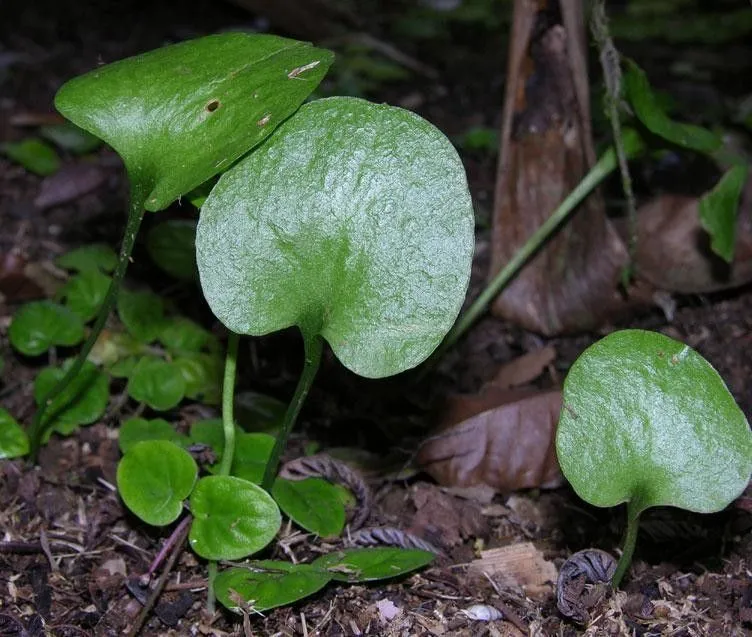
Author: L.
Bibliography: Sp. Pl.: 1063 (1753)
Year: 1753
Status: accepted
Rank: species
Genus: Ophioglossum
Vegetable: False
Observations: Tropics & Subtropics
Netted adderstongue, known scientifically as Ophioglossum reticulatum, is a fascinating species that captures the interest of botanists and plant enthusiasts alike. First described by the renowned botanist Carl Linnaeus in his seminal work Species Plantarum in 1753, this unique plant belongs to the Ophioglossaceae family.
The natural habitat of the Netted adderstongue spans the tropics and subtropics, indicating its preference for warm and humid environments. This widespread distribution demonstrates the plant’s adaptability and resilience in various climatic conditions. The species is well-named for its distinctive appearance: the fronds display a reticulated, or net-like, pattern, which is quite characteristic and aids in its identification.
Ophioglossum reticulatum is a small perennial fern, and like others in its family, it features a simple and unbranched structure. The fronds are typically composed of a single leaf blade that unfurls in a unique manner reminiscent of a serpent’s tongue, thus the moniker “adderstongue.” This morphological trait not only distinguishes it visually but also contributes to the plant’s allure in botanical collections and studies.
In addition to its intriguing form, the Netted adderstongue plays an important role in its ecosystem. As a fern, it contributes to the ecological balance by providing ground cover and aiding in soil retention, which helps prevent erosion in tropical forest floors. Its presence signifies a healthy and biodiverse environment, supporting a range of microbial and insect life that thrives in the understory of tropical forests.
Despite its specific niche, the Netted adderstongue is relatively hardy and demonstrates a remarkable ability to thrive in various conditions within its preferred climate zones. This adaptability can be attributed to its evolutionary history and physiology, which equip it to handle differences in moisture and light availability.
In conclusion, the Netted adderstongue (Ophioglossum reticulatum) is a noteworthy species within the tropical and subtropical regions. Its distinctive reticulated fronds, unique morphologic features, and ecological role make it an important and interesting plant for study and conservation. Understanding and preserving such species is crucial for maintaining the health and diversity of our planet’s tropical ecosystems.
Eng: netted adder’s-tongue, netted adderstongue
En: Netted adderstongue, Netted Adder’s-Tongue
Fr: Ophioglosse réticulé
© copyright of the Board of Trustees of the Royal Botanic Gardens, Kew.
© copyright of the Board of Trustees of the Royal Botanic Gardens, Kew.
© copyright of the Board of Trustees of the Royal Botanic Gardens, Kew.
Taken Oct 18, 2020 by Santhosh Kumar (cc-by-sa)
Taken Apr 17, 2019 by OTS – O. Vargas (cc-by-nc-sa)
Taken Sep 13, 2019 by Sánchez Johysmer (cc-by-sa)
Taken Oct 18, 2020 by Santhosh Kumar (cc-by-sa)
Taken Apr 17, 2019 by OTS – O. Vargas (cc-by-nc-sa)
Taken Apr 17, 2019 by OTS – O. Vargas (cc-by-nc-sa)
Taken Nov 23, 2004 by Royal Botanic Garden Edinburgh – Anthony G. Miller (cc-by-nc)
Taken Nov 23, 2004 by Royal Botanic Garden Edinburgh – Anthony G. Miller (cc-by-nc)
Taken Nov 23, 2004 by Royal Botanic Garden Edinburgh – Anthony G. Miller (cc-by-nc)
Taken Apr 17, 2019 by OTS – O. Vargas (cc-by-nc-sa)
Taken Nov 23, 2004 by Royal Botanic Garden Edinburgh – Anthony G. Miller (cc-by-nc)
Taken Nov 23, 2004 by Royal Botanic Garden Edinburgh – Anthony G. Miller (cc-by-nc)
Taken Apr 17, 2019 by OTS – O. Vargas (cc-by-nc-sa)
Taken Apr 17, 2019 by OTS – O. Vargas (cc-by-nc-sa)
Growth habit>: Forb/herb
Family: Myrtaceae Author: (F.Muell.) K.D.Hill & L.A.S.Johnson Bibliography: Telopea 6: 402 (1995) Year: 1995 Status:…
Family: Rubiaceae Author: Pierre ex A.Froehner Bibliography: Notizbl. Bot. Gart. Berlin-Dahlem 1: 237 (1897) Year:…
Family: Sapindaceae Author: Koidz. Bibliography: J. Coll. Sci. Imp. Univ. Tokyo 32(1): 38 (1911) Year:…
Family: Asteraceae Author: A.Gray Bibliography: Pacif. Railr. Rep.: 107 (1857) Year: 1857 Status: accepted Rank:…
Family: Fabaceae Author: Medik. Bibliography: Vorles. Churpfälz. Phys.-Ökon. Ges. 2: 398 (1787) Year: 1787 Status:…
Family: Aspleniaceae Author: (Cav.) Alston Bibliography: Bull. Misc. Inform. Kew 1932: 309 (1932) Year: 1932…